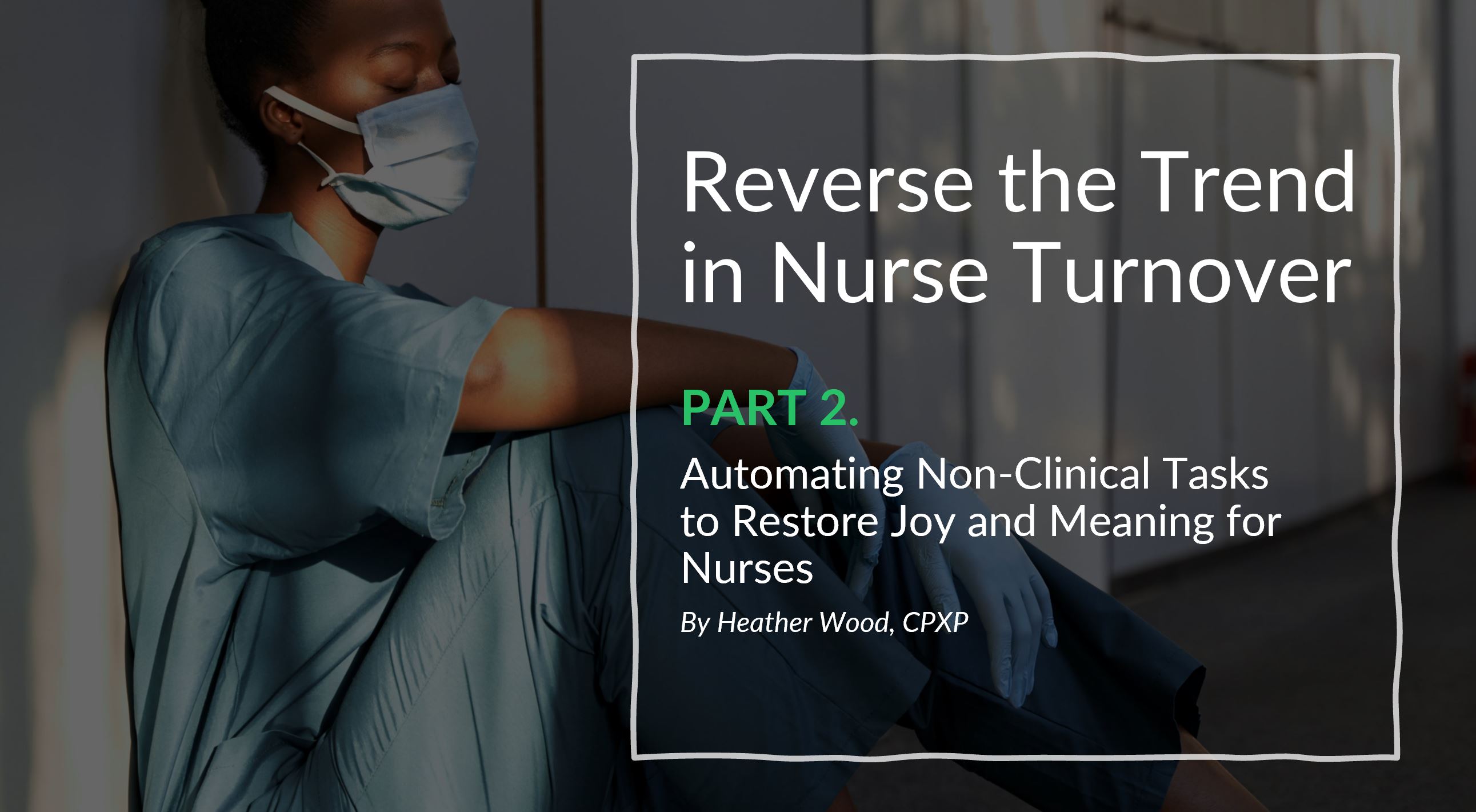
Reverse the Trend in Nursing Turnover
Part 2: Automating Non-Clinical Tasks to Restore Joy and Meaning for Nurses
Heather Wood, CPXP, VP, Clinical Innovation, eVideon
If you ask a nurse why they chose their profession, you’re likely to hear messages of empathy and a genuine desire to help people. Nurses enjoy caring for patients and bringing joy back to the profession should be atop priority for organizations who want to retain stellar nursing staff. In fact, as of December 31, 2021, LinkedIn listed ‘Registered Nurse’ as the fourth-most in-demand job in the American workforce. With the role in such high demand, what can healthcare organizations do to attract and retain top talent?
When the Institute for Healthcare Improvement (IHI) released the IHI Framework for Improving Joy in Work, they identified that increasing demands on time, resources, and energy, in addition to poorly designed systems of daily work, contributed to health care professionals experiencing burnout at increasingly higher rates. One way to increase joy while decreasing the burnout risk is to give nurses useful resources that allow them to focus on patient care rather than trivial tasks.
Automating administrative tasks and routing non-clinical requests can reduce paperwork, interruptions, and manual processes, all of which put stress on nursing staff and drain the profession of joy and fulfillment. The process is simple: leverage information from the EMR (yes - any EMR) and integrate it with patient-facing solutions to create a non-clinical self-service environment for patients and families, all while enabling nurses to practice at the top of their license.
THINKING BEYOND THE CALL BELL
The nurse call bell, in theory, is necessary and wonderful as it offers patients a way to easily get the help they need. But what if the patient doesn’t require clinical help? What if the patient simply has a question, wants a beverage, or need a blanket? It is these types of non-clinical requests that consume a nurse’s day and contribute to nurse fatigue. Beyond that, some patients may be hesitant to seek those comforts out of fear of disturbing the nurses, which may impact their overall hospital experience.
It’s time to think beyond the “call bell.” Today’s communication systems allow for instant, seamless communication, as well as triaging of notifications to proper departments, not just nursing. Giving patients a menu of available options will put them at ease, enable self-service, and significantly decrease the interruptions nurses experience throughout their day.
As an example, a large health system in Florida provides patients with a menu of services they can choose from throughout their stay. This menu includes twenty-seven (27) distinct services from nine unique departments throughout the hospital, including:
- Housekeeping
- Food Service
- Spiritual Care
- Guest Services
- Gift Shop
- Case Management
- Engineering
- Patient Advocacy
- Rehabilitation Services
Imagine eliminating 27 tasks from the day-to-day schedule of your nursing staff?! And imagine automatically triage these requests to the proper department to ensure more timely delivery of service? By thinking beyond the traditional call bell and leveraging interactive in-room systems, hospital scan save nurses steps and give them more time to practice clinical care, thus bringing fulfillment and meaning back to the role of nursing.
INTEGRATING TECHNOLOGIES TO STANDARDIZE PRACTICES
In a world where patient information is digitized, there’s no need for dry erase boards, handwritten charts, or cryptic magnet or paper signage systems outside patient rooms. The EMR contains endless amounts of data, critical health information that is up-to-the-minute, reliable, and standardized. Instead of tasking nurses with replicating information manually onto dry erase boards (not to mention tracking down markers that actually work), those tasks and displays can be automated. A simple integration with the EMR means accurate data can be displayed anywhere, any time, on any device, without nurses having to manually update it.
Similarly, documenting rounds can be a cumbersome task. But capturing RTLS information in a “smart” patient room removes that task. Each entry into a patient room can be automatically logged, and nursing staff can electronically document other rounding details that update on each device.
Outside the patient room, integrated technologies can automatically update door displays to show patient precautions (e.g., allergies, fall risk, etc.), rather than placing the burden on nurses to, again, replicate information to yet another board. Digital door signs and digital whiteboards not only save time and create efficiency, they standardize processes for clinicians to ensure safety and high reliability across an organization.
REMEMBERING EMPATHY
Ultimately, nurse retention isn’t just about tools and technology. It’s about how those tools and technology--along with a positive work environment and culture--work together to contribute to nurse satisfaction. The patient environment is a significant part of that. Patient experience and nurse experience are intrinsically tied. Creating a supportive environment in which technology reduces complexity and helps patient outcomes also creates an environment where nurses feel rewarded and that their clinical efforts matter. Nurses chose medicine because they want to make a difference and help patients get better, let's use today's technology to let them.
I'd love to hear your thoughts on this topic, feel free to email me with your ideas and questions!
Contact us to learn more about automating non-clinical service requests >
